Notifications in iOS
Types of notifications
We can broadly classify notifications into 2 categories,
- Local notifications — app configures the notification details locally and passes those details to the system, which then handles the delivery of the notification when the app is not in the foreground.
- Remote notifications — use one of your company’s servers to push data to user devices via the Apple Push Notification service(APNs).
Further in the article, we’ll see how we can get hold of both the notification types. Let’s first start with the introduction to the very new notification framework that we can use to our cause.
What’s new in iOS-10 for Notifications?
With the release of iOS-10, Apple introduced 2 new frameworks to handle notifications,
- User Notifications Framework — manages both local and remote notifications.
- User Notifications UI Framework — customize the appearance of the system’s notification interface.
We’ll be using these 2 frameworks and some platform-specific APIs to configure our notifications.
Along with the frameworks, Notification service app extension was also introduced that allows modifying the content of remote notifications before they are delivered.
Apple also allowed customising the notifications UI though Notification content extension.
Is it too much to remember? Yup..surely it is. But, don't worry. We’ll see everything step-by-step along with the relevant code. Just take it easy..😉
First Step First — Configure it..!!
Request Authorization
To get our app notify anything, we need to know whether the person using it actually wants that at the first place. May be he don’t like his phone ringing and displaying alerts all the time 😖..or may be he actually want the updates but not that irritating sound..naahhh..!!!☠️
So, first of all we need to take the permission from the one we’re going to notify. And that’s pretty simple, just 2 lines of code and we’re done.
| let center = UNUserNotificationCenter.current() | |
| center.requestAuthorization(options: [.badge, .sound, .alert]) { (granted, error) in | |
| //granted = yes, if app is authorized for all of the requested interaction types | |
| //granted = no, if one or more interaction type is disallowed | |
| } |
Code Snippet — 1
You need to write that code in
AppDelegate’s method — application:didFinishLaunchingWithOptions:before returning from it.
Point to be noted: Because the system saves the user’s response, calls to
requestAuthorization(options:completionHandler:) method during subsequent launches do not prompt the user again.Adding Categories and Actions — Actionable Notifications
The user notifications framework supports adding categories and actions to the notifications.
Categories — Define the types of notifications that the app supports and communicate to the system how we want a notification to be presented.
Actions — Each category can have up to four actions associated with it. Actions are basically custom buttons, that on tap dismisses the notification interface and forwards the selected action to app for immediate handling.
Okayyy..!!! And what does that mean..????🤔 Some code might help you understand that better.
| //Actions | |
| let remindLaterAction = UNNotificationAction(identifier: "remindLater", title: "Remind me later", options: UNNotificationActionOptions(rawValue: 0)) | |
| let acceptAction = UNNotificationAction(identifier: "accept", title: "Accept", options: .foreground) | |
| let declineAction = UNNotificationAction(identifier: "decline", title: "Decline", options: .destructive) | |
| let commentAction = UNTextInputNotificationAction(identifier: "comment", title: "Comment", options: .authenticationRequired, textInputButtonTitle: "Send", textInputPlaceholder: "Share your thoughts..") | |
| //Category | |
| let invitationCategory = UNNotificationCategory(identifier: "INVITATION", actions: [remindLaterAction, acceptAction, declineAction, commentAction], intentIdentifiers: [], options: UNNotificationCategoryOptions(rawValue: 0)) | |
| //Register the app’s notification types and the custom actions that they support. | |
| center.setNotificationCategories([invitationCategory]) |
In the above code, we simply created a category named INVITATION with 4 different actions — remindLater, accept, decline, comment.
The categories and actions are uniquely identified by their identifiers. Whenever a notification with a category is delivered, the system presents the notification along with all the actions associated with that category once the user expands it. This is what it will look like 👇,
Define all the categories and actions just below where you configured notifications in
application:didFinishLaunchingWithOptions: method.
Include the category identifier (eg. INVITATION) while scheduling your notification whether locally or remotely. We’ll see how to do that in the next section.
Scheduling Local Notification
Now that we’re done with configuring our notifications, let’s see how to actually schedule one from within the app.
Scheduling a local notification is just 3 simple steps,
- Prepare the content
- Add a trigger — when the notification should be fired
- Schedule it for delivery
Let’s get on with the code quickly, so we don’t get confused with everything happening here. LOL 😝
| //Notification Content | |
| let content = UNMutableNotificationContent() | |
| content.title = "Invitation" | |
| content.subtitle = "This is a Local Notification." | |
| content.body = "You are invited." | |
| content.categoryIdentifier = "INVITATION" | |
| content.sound = UNNotificationSound.default() | |
| //Notification Trigger - when the notification should be fired | |
| let trigger = UNTimeIntervalNotificationTrigger(timeInterval: 5, repeats: false) | |
| //Notification Request | |
| let request = UNNotificationRequest(identifier: "Anniversary", content: content, trigger: trigger) | |
| //Scheduling the Notification | |
| let center = UNUserNotificationCenter.current() | |
| center.add(request) { (error) in | |
| if let error = error | |
| { | |
| print(error.localizedDescription) | |
| } | |
| } |
In the above code along with the other content, we have also provided a
categoryIdentifier to support actionable notifications. In case we don’t do that, the system will adopt it’s default behavior.
That’s it. That’s all needed. And yes it definitely works..hehehe..😝 Give it a try before moving any further. You can download the sample from here.
App behaves differently in background and foreground states whenever a notification is delivered.
- App not running / App in Background — the system displays local notifications directly to the user. We don’t get any callback in the app for that.
- App in Foreground — the system gives app the opportunity to handle the notification internally. The system silences notifications for foreground apps by default.
When app is in foreground while the notification is delivered, we get the callback in
UNUserNotificationCenterDelegate's method — userNotificationCenter(_:willPresent:withCompletionHandler:) where you can decide whether to handle the notification silently or alert the user about it.| //Here you decide whether to silently handle the notification or still alert the user. | |
| func userNotificationCenter(_ center: UNUserNotificationCenter, willPresent notification: UNNotification, withCompletionHandler completionHandler: @escaping (UNNotificationPresentationOptions) -> Void) | |
| { | |
| //Write you app specific code here | |
| completionHandler([.alert, .sound]) //execute the provided completion handler block with the delivery option (if any) that you want the system to use. If you do not specify any options, the system silences the notification. | |
| } |
Don’t forget to conform
AppDelegate to UNUserNotificationCenterDelegateprotocol and setting it as the delegate of UNUserNotificationCenter shared object in application:didFinishLaunchingWithOptions:.let center = UNUserNotificationCenter.current()
center.delegate = self
We’re done with local notifications for now. Let’s move on to how we can schedule a notification from outside our app. Before that, let’s have a look on how to respond to the custom actions.
Responding to User Actions
Configuring notifications?? ✔ Scheduling notifications?? ✔
What about tapping a notification or any custom action in the notification? Where will it lead to? — in both the cases, system notifies the app of the user’s choice.
Whenever the user performs any action in the notification, the response is sent to
UNUserNotificationCenterDelegate's method — userNotificationCenter(_:didReceive:withCompletionHandler:), where we can provide handling specific to each action.| func userNotificationCenter(_ center: UNUserNotificationCenter, didReceive response: UNNotificationResponse, withCompletionHandler completionHandler: @escaping () -> Void) | |
| { | |
| switch response.notification.request.content.categoryIdentifier | |
| { | |
| case "GENERAL": | |
| break | |
| case "INVITATION": | |
| switch response.actionIdentifier | |
| { | |
| case "remindLater": | |
| print("remindLater") | |
| case "accept": | |
| print("accept") | |
| default: | |
| break | |
| } | |
| default: | |
| break | |
| } | |
| completionHandler() | |
| } |
Point to be noted — if the app is not running when a response is received, the system launches the app in the background to process the response.
Remote Notifications
Push notification or remote notifications, no matter what we call it, it’s one of the most frequestly used one with lots and lots of use-cases.
Be it social media or calendar or any of the utilities app, we could see them almost everywhere. News apps notifying us of the latest content, medium itself alerting us of the latest published articles.
Ever wondered how do they even do that? Local Notifications ???🤔 It could be..it does the same thing..right? May be we can do some more configuration in the local one itself and get that working? But medium for example, don’t have access to the app on our personal device, so how could it schedule any notification? Exactly!!! It can’t. This is something different and something more just than the local ones.
Send the notification from some point and show it at some other point — will this answer our question? Yupp..surely it will. But how to do that? Remote Notifications it is. This is exactly what it does. This is the feature that has solved THE BIG PROBLEM of “Keeping up-to-date”.
Terminology
- APNs —It is the centerpiece of the remote notifications feature. It is a cloud service that allows approved third-party apps installed on Apple devices to send push notifications from a remote server to users over a secure connection.
- Device Token — An app-specific token that is globally unique and identifies one app-device combination. It enables communication between Provider, APNs and Device.
- Provider — Server that actually sends the remote notification including the device token and other information to APNs.
Never cache device tokens in your app; instead, get them from the system when you need them.
APNs issues a new device token to your app when certain events happen. The device token is guaranteed to be different, for example, when a user restores a device from a backup, when the user installs your app on a new device, and when the user reinstalls the operating system.
When you attempt to fetch a device token but it has not changed, the fetch method returns quickly.
Point to be noted — The ability of APNs to deliver remote notifications to a nonrunning app requires the app to have been launched at least once.
How it actually works?
Below is a small and quick explanation of how all the above technologies work together in sync to complete the remote notifications workflow.
- App registers with APNs
- APNs sends device token to Device with then sends it to App
- App sends this device token to Provider
- Provider sends notifications with that device token to APNs which then sends it to Device which then sends it to the App.
If a notification for your app arrives with the device powered on but with the app not running, the system can still display the notification. If the device is powered off when APNs sends a notification, APNs holds on to the notification and tries again later.
Handle it in the App
Now that we are aware of what remote notifications are and what all things are needed to make it work, let’s now move on to how we can make our app support it. Obviously, nothing happens on its own 😉. We need to make some configurations for the same. To be able to handle remote notifications, our app must:
- Enable remote notifications in capabilities — just one-click and you are done with this step. In the Capabilities tab of our Xcode project, enable Push Notifications option. Ensure that Push Notifications is added to the App ID that we are using for the project.
2. Register with Apple Push Notification service (APNs) and receive an app-specific device token
Requesting to register with APNs is quick and easy. Just add the below code in
UIApplicationDelegate’s method— application:didFinishLaunchingWithOptions: before returning from it.UIApplication.shared.registerForRemoteNotifications()
Now there can be 2 possibilities, either we get registered successfully or the process fails.
On successful registration, APNs sends an app-specific device token to the device in
UIApplicationDelegate’s method— application:didRegisterForRemoteNotificationsWithDeviceToken:.
In case of faliure, we receive a callback in
UIApplicationDelegate’s method—application:didFailToRegisterForRemoteNotificationsWithError:.func application(_ application: UIApplication, didRegisterForRemoteNotificationsWithDeviceToken deviceToken: Data)
{
let tokenParts = deviceToken.map { data -> String in
return String(format: "%02.2hhx", data)
}
let token = tokenParts.joined()
print("Device Token: \(token)")
}
func application(_ application: UIApplication, didFailToRegisterForRemoteNotificationsWithError error: Error)
{
print(error.localizedDescription)
}
3. Send the device token to notification provider server
As of now, we’ve received the device token from APNs. Now, we need to send this token to our provider, which will use it while pushing any notifications to our device.
Since we don’t have a provider, for now we can use Easy APNs Provider for testing our push notifications. Further in the sections, we’ll see how exactly we can make use of this tool.
For now, just download and install it on your mac.
4. Implement support for handling incoming remote notifications
We have got our device token and our provider also knows about it. Next, the Provider will send the notification including this token and other information in it and we’ll get it on our device.
Now what? What will happen when it arrives? How will it appear on the device? What will happen when we tap on it? What about all the actions that we configured earlier? Can we get them here?
Too many question ❓❓❓..Well, don’t worry. We’ll have answers to all of them one-by-one.
- What will happen when it arrives — we’ll get a callback in
UIApplicationDelegate’smethod—application(_:didReceiveRemoteNotification:fetchCompletionHandler:). It tells the app that a remote notification has arrived that indicates there is data to be fetched. - How will it appear on the device — it will appear with the default notification interface. If the notification’s payload is configured with category, it will appear as the actionable notification with all the actions attached to that category. We’ll discuss about the payload in next section.
- What will happen when we tap on it — same as local notifications.
UNUserNotificationCenterDelegate'smethod —userNotificationCenter(_:didReceive:withCompletionHandler:)is called with the response object.
Handle it on the Provider
We have covered most of the things we need to integrate push notifications into our app. Although we know how to handle it in the app, we are still short of handling it on the provider.
We have the provider. It knows what device token to use, but that solely won’t pop a notification on our device with some title and other details. Neither will it make any of the actions appear. So, pushing notifications from the provider needs the following items,
- A device token
- APNs certificate — we can obtain it from the developer account
- Payload — any custom data that you want to send to your app and includes information about how the system should notify the user. Its simply a JSON dictionary with some key value pairs. The below illustration might help you understand it better.
| { | |
| "aps": { | |
| "alert": { | |
| "title": "Invitation", | |
| "subtitle": "This is a Remote Notification.", | |
| "body": "You are invited." | |
| }, | |
| "category": "INVITATION", | |
| "sound": "default", | |
| "content-available": 1, | |
| "mutable-content": 1 | |
| } | |
| } |
Let’s see what’s all in that JSON dictionary,
- aps dictionary — the most important one. Contains Apple-defined keys and is used to determine how the system receiving the notification should alert the user.
- alert dictionary — it is more of a self-explanatory item. Provides the content of the notification.
- category — for actionable notifications. All the actions attached to that category will be available in the notifications.
- content-available — To support a background update notification set this key to 1.
- mutable-content — To enable notification’s modification through Notification Service App Extension, set it to 1.
Notification Service App Extension
Uptill now, we know what remote notifications are..how they work..what all we need to get them working..everything..we just got them working perfectly..✌️.
Now question is, what if we want to modify some content in the notification received from provider, before presenting it on the device? What if the notification contains some image link that we need to download before delivering it to the user? Can we do that with what all we already know? We don’t have access to the provider..so how will we?
We can’t actually. We can’t change what we get..but we can definitely change what we present.
That’s what Notification Service App Extension is all about— modifying the content of remote notification before delivery. It is as simple as it looks like. No fancy code..nothing..very simple.
Adding Notification Service Extension to the Project
Extensions in an xcode project are added as a target. Select File — New — Target — Notification Service Extension.
Prerequisites
Before we begin to modify the content, there are some restrictions on when the content is allowed to be modified. Content can be modified only if:
- The remote notification is configured to display an alert.
- The remote notification’s aps dictionary includes the mutable-content key with the value set to 1.
We cannot modify silent notifications or those that only play a sound or badge the app’s icon.
Hence, to support any modifications in the notifications’ content, these conditions must be fulfilled.
Modifying the content
The default notification service extension target provided by Xcode contains a subclass of the
UNNotificationServiceExtension class for us to modify.
It contains 2 methods:
didReceive(_:withContentHandler:)— make any needed changes to the notification and notify the system when you’re done. This method has a limited amount of time (about 30 secs) to perform its task and execute the provided completion block.serviceExtensionTimeWillExpire()— Tells us that your extension is about to be terminated. Give us one last chance to submit our changes. If we don’t update the notification content before time expires, the system displays the original content.
Let’s look at an example. We’ll change the body in payload in Code Snippet — 7to “Address: Sea Shells Apartments, Mumbai”.
override func didReceive(_ request: UNNotificationRequest, withContentHandler contentHandler: @escaping (UNNotificationContent) -> Void)
{
self.contentHandler = contentHandler
bestAttemptContent = (request.content.mutableCopy() as? UNMutableNotificationContent)
if let bestAttemptContent = bestAttemptContent
{
// Modify the notification content here...
bestAttemptContent.body = "Address: Sea Shells Apartments, Mumbai" //Here..!!!
contentHandler(bestAttemptContent)
}
}
All the default implementation of both the methods is provided by the extension itself. We just have to make the changes we want, like in Line — 8 in the above code snippet. Just a single line of code for now. Similarly, you can modify other fields as per your requirements.
Notification Content Extension
Having an eye-catching UI is any time better than a default simple UI. Adding some colors..some pretty fonts is never a bad idea. We’re going to do the same with our notifications, make them look Woww..!!!😍
And and and…Apple is here to our rescue again. Notification content extensionit is — presents a custom interface for a delivered local or remote notification.
Adding Notification Content Extension to the Project
I think we already know how to do that. Isn’t it? We’re going to the same what we did for adding Notification Service Extension. Select File — New — Target — Notification Content Extension.
Adding some keys to extension’s Info.plist
To support custom UI for local & remote notifications, we need to make some changes in the Info.plist file of content extension.
- UNNotificationExtensionCategory (reqd.) — A string or an array of strings. Each string contains the identifier of a category declared by the app. Category, I must say is really really important for notifications. Custom UI will only appear for the notifications lying in the specified categories.
- UNNotificationExtensionInitialContentSizeRatio (reqd.) — A floating-point number that represents the initial size of the view controller’s view expressed as a ratio of its height to its width. It’s the view controller that we’ll use for making custom UI. We’ll discuss that in the upcoming section.
- UNNotificationExtensionDefaultContentHidden — true: show only custom content, false: show custom+default content.
- UNNotificationExtensionOverridesDefaultTitle — true: set the notification’s title to the title of the view controller, false: notification’s title is set to app’s name.
Here is an illustration that can help us understand the above keys better.
In the above illustration, the keys in Info.plist are configured as:
- UNNotificationExtensionCategory — INVITATION
- UNNotificationExtensionInitialContentSizeRatio — 1
- UNNotificationExtensionDefaultContentHidden — false
- UNNotificationExtensionOverridesDefaultTitle — false
Creating Custom UI
Notification content extension, provide us with a
UIViewController that conforms to UNNotificationContentExtension protocol. This controller presents the interface of the notification. The Storyboard file in the extension contains a single ViewController that we can use to create whatever UI we want the notification to present.
Once we create the UI, we need to connect the elements in the
NotificationViewController in order to fill in the details. Whenever a notification arrives with an expected category, we receive a callback in UNNotificationContentExtension’s method — didReceive(_:) . This is the place where we can add details to our customised UI.func didReceive(_ notification: UNNotification)
{
self.titleLabel?.text = notification.request.content.title
self.subTitleLabel?.text = notification.request.content.subtitle
self.bodyLabel?.text = notification.request.content.body
}
We’re almost done with our notification’s custom UI. Just 1 more thing. Since the custom UI is attached to the notifications’ category that may have some actions attached to it. And..you got that right..!!! 🤘We’ll get our actions automatically without any custom handling. Brilliant..!!!👏
Content + Beautiful UI + Custom Actions — Everything done. What more can we ask for. Apple..you are great..!!!🤩
Last point, we can add handling to the custom actions in the extension too. The system calls
didReceive(_:completionHandler:) method to respond to any selected actions. If our view controller doesn’t implement that method, the system delivers the selected action to your app for handling.func didReceive(_ response: UNNotificationResponse, completionHandler completion: @escaping (UNNotificationContentExtensionResponseOption) -> Void)
{
if response.actionIdentifier == "accept"
{
print("Accept - from Extension")
DispatchQueue.main.async {
completion(.dismissAndForwardAction)
}
}
else
{
DispatchQueue.main.async {
completion(.dismiss)
}
}
}
If implemented, we need to handle all the possible actions in this method. One thing that is important here is the
completion closure.
completion
The block to execute when you are finished performing the action. You must call this block at some point during your implementation. The block has no return value
The closure accepts a single parameter
dismiss of type UNNotificationContentExtensionResponseOption . We provide the following options:doNotDismiss— Don’t dismiss the notification interface.dismiss— Dismiss the notification interface.dismissAndForwardAction--Dismiss the notification interface and forward the notification to the app.
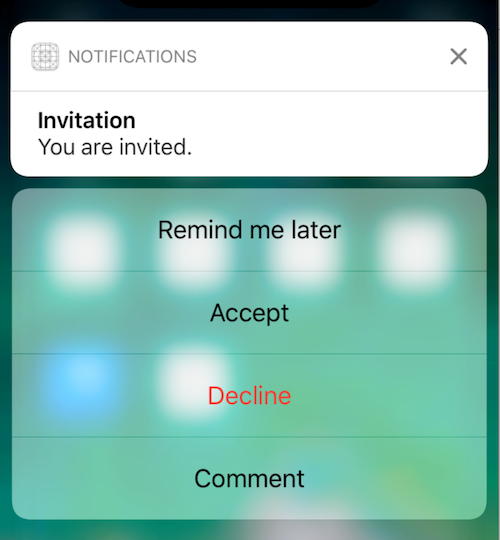

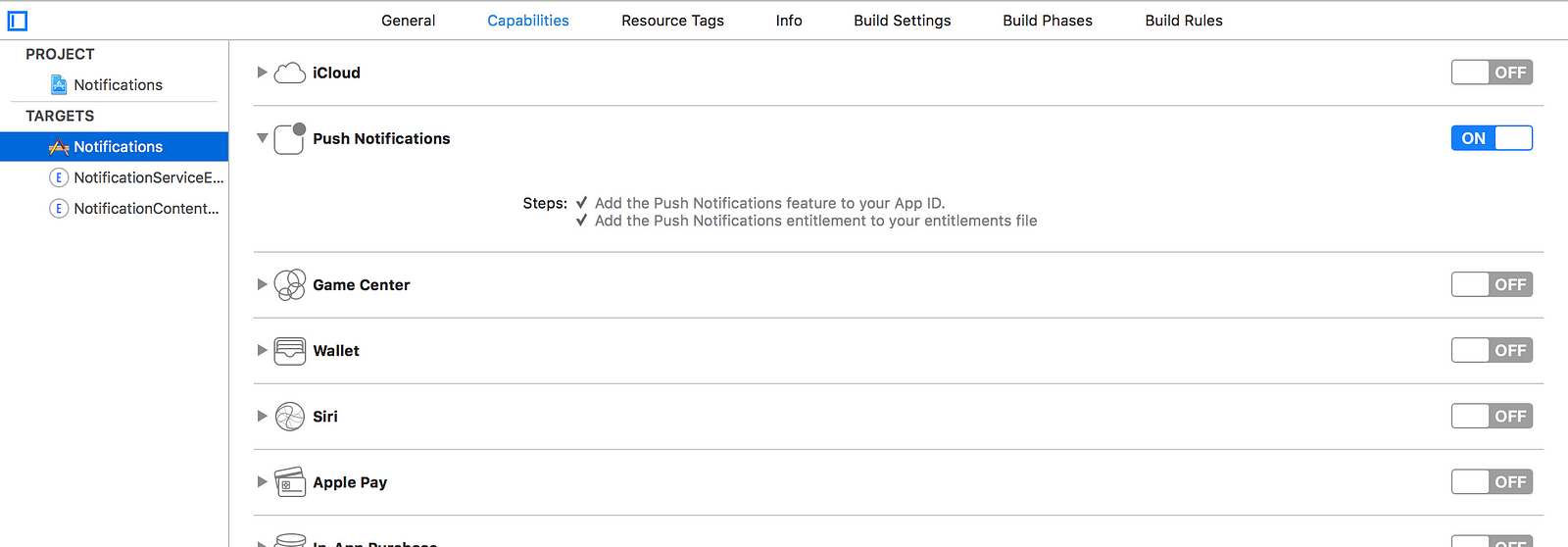
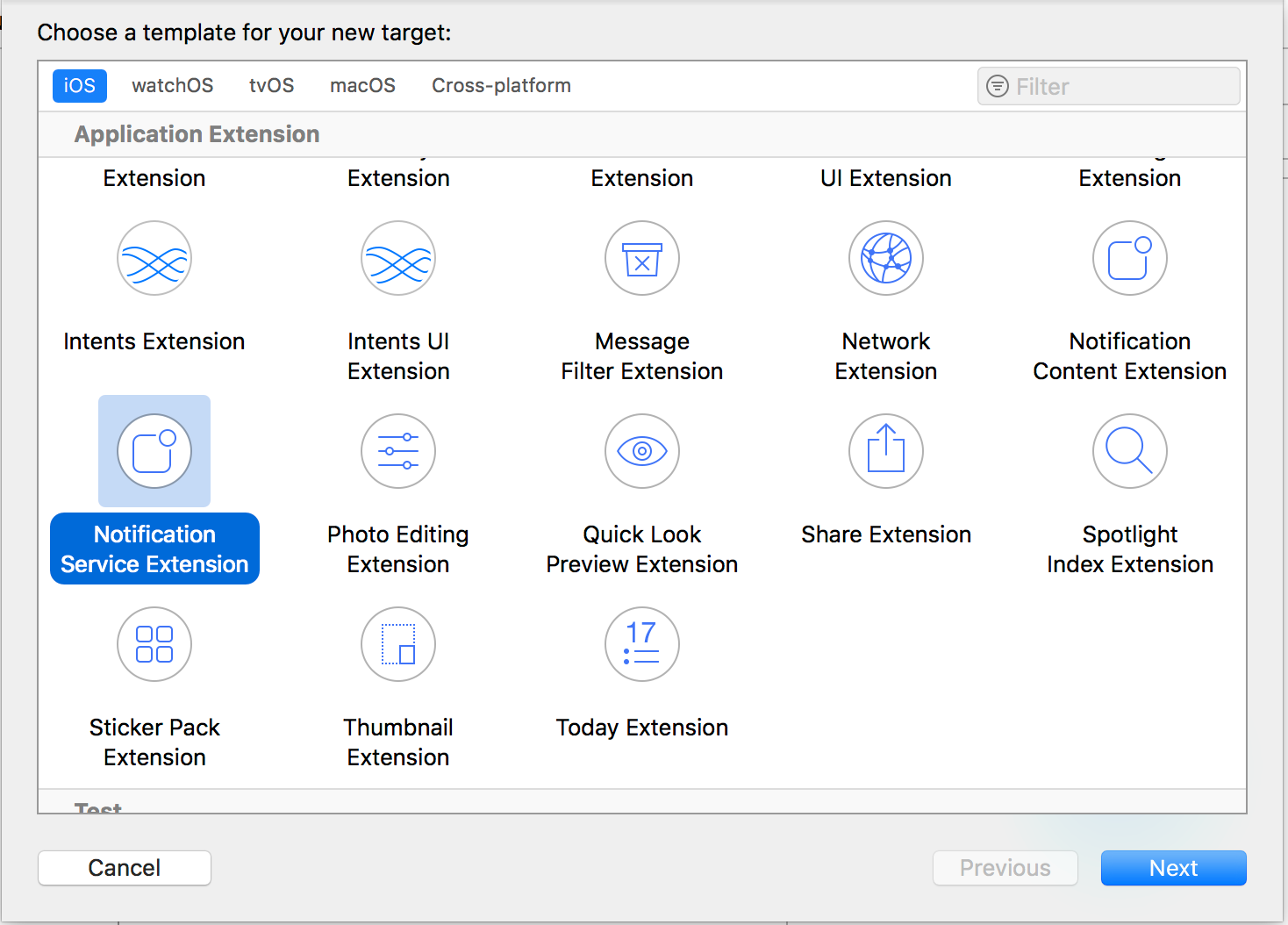
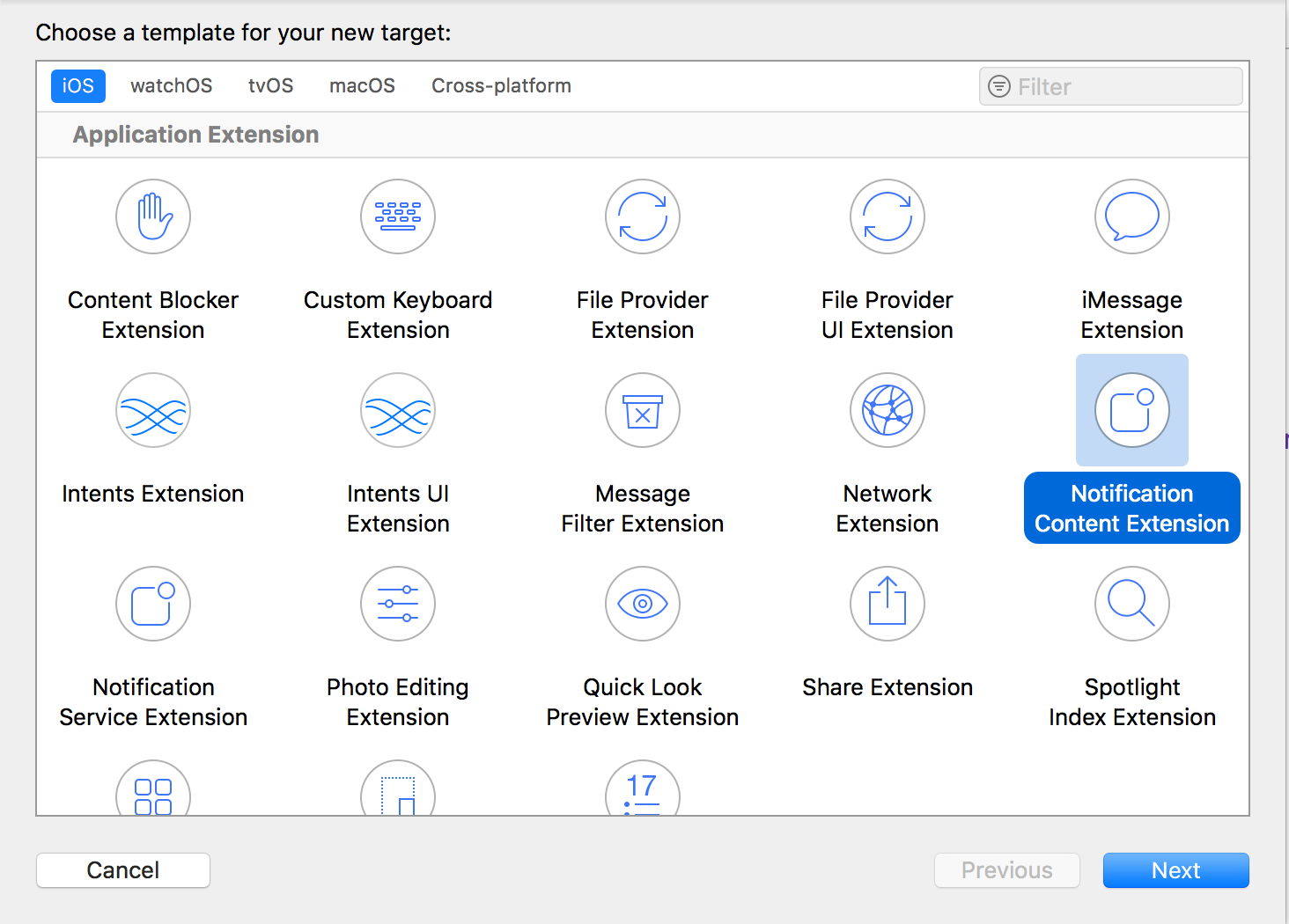
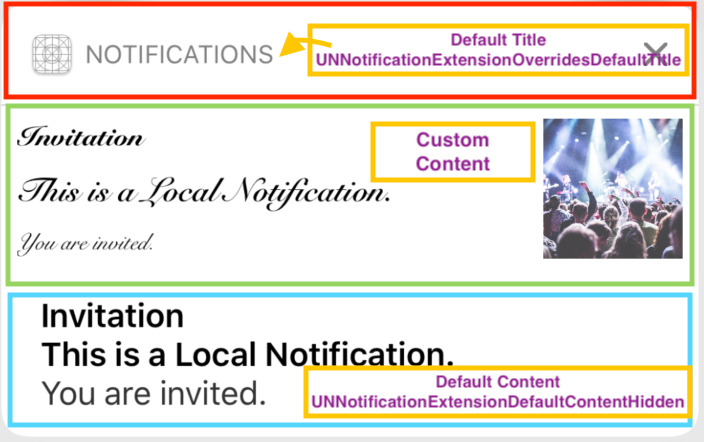
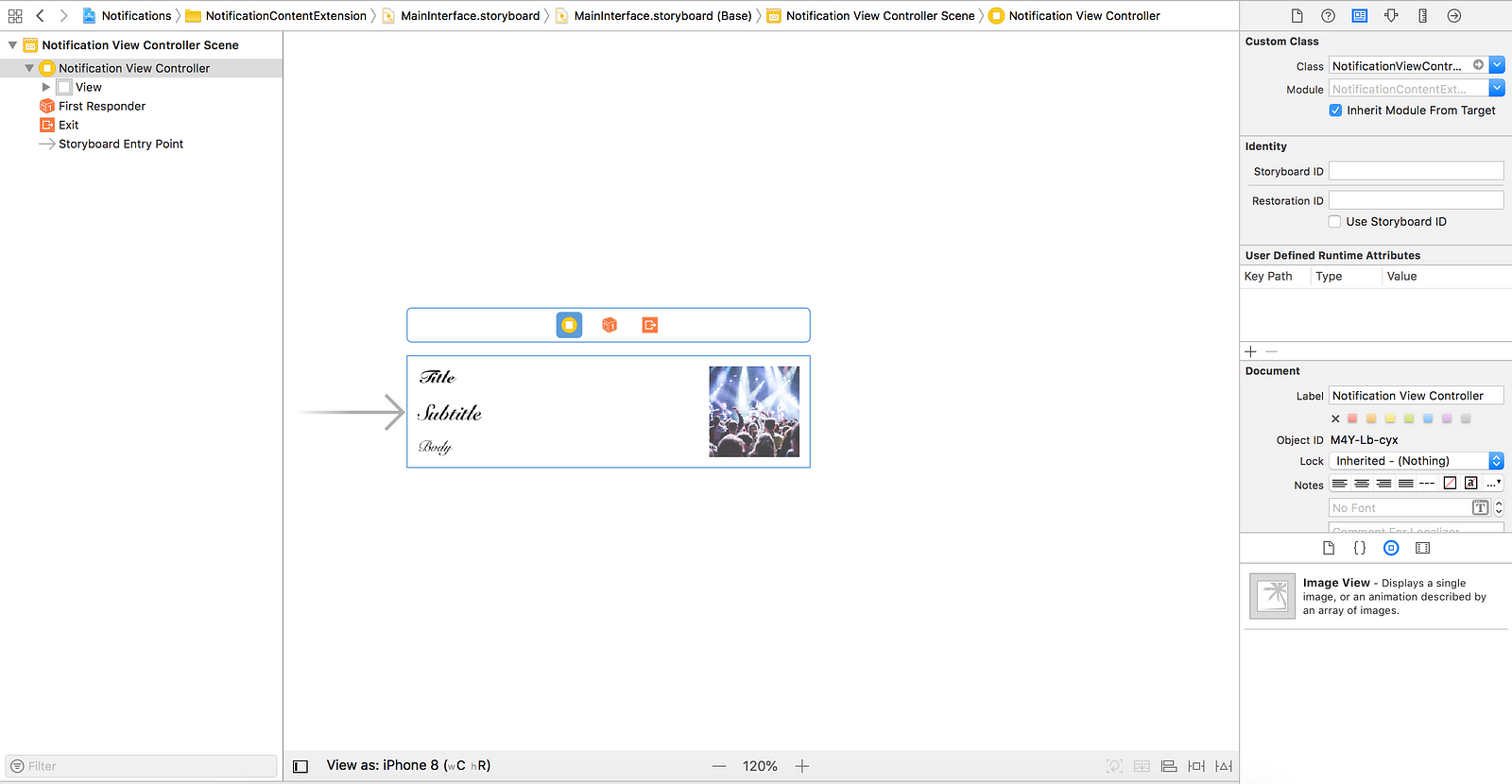
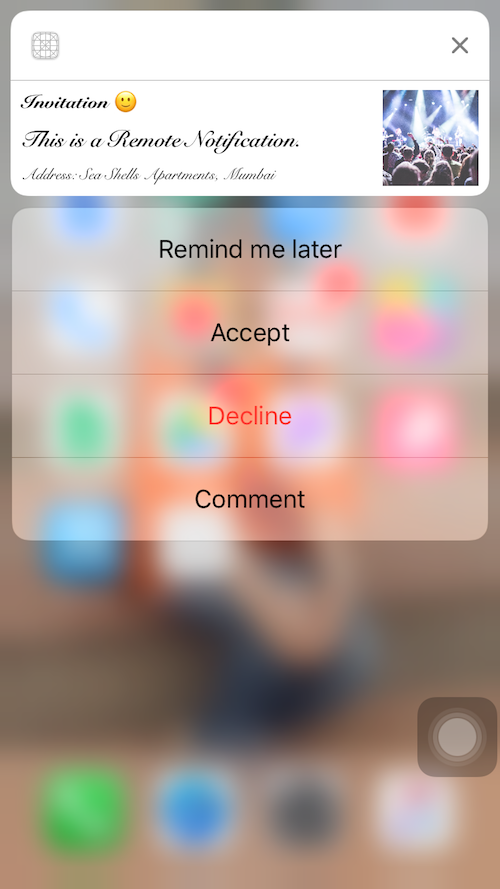
Comments
Post a Comment